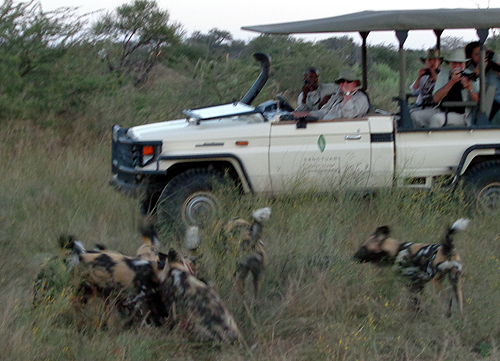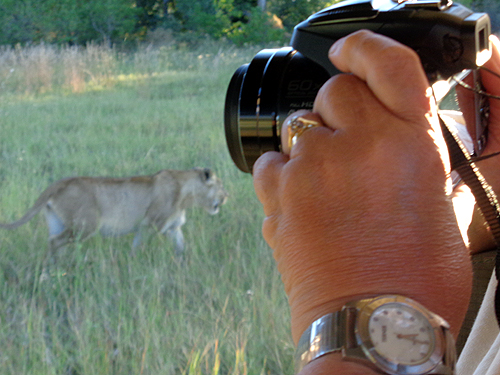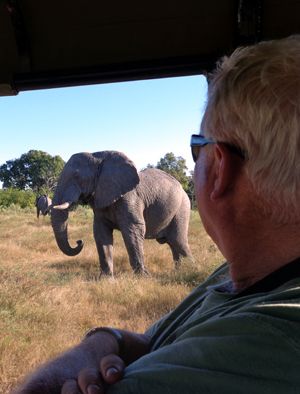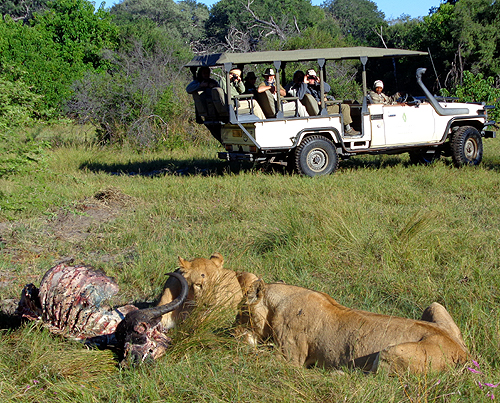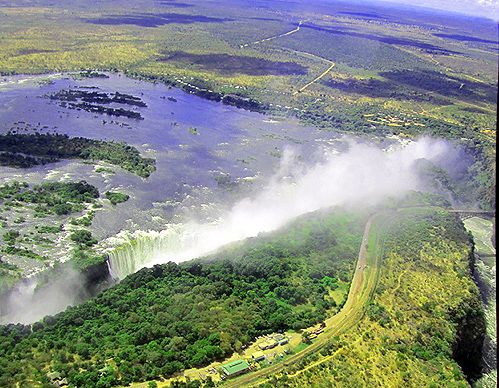 Like Iguassu, Niagra and Angel, Victoria Falls is a stunning creation of nature, a Disney production of Mother Earth, commercialized to be sure yet still a pure wonder.
Like Iguassu, Niagra and Angel, Victoria Falls is a stunning creation of nature, a Disney production of Mother Earth, commercialized to be sure yet still a pure wonder.
Imagine an alien world where there is so much water and so many water falls that the prize of a holiday is a piece of highveld Montana. But for us earthlings, sheaves of water tumbling from high rock is so rare that it’s beauty incarnate.
And Victoria Falls couldn’t better fit the description, because it’s likely that visitors here have spent a good amount of their vacation in flat near desert, as we did in the Makgadikgadi and as many others do in the Kalahari, where an errant stream or evaporating pan represents paradise.
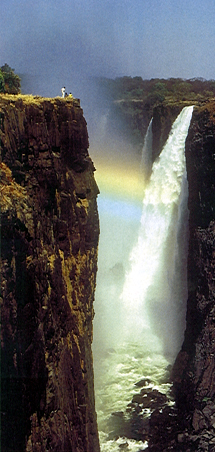 Then, suddenly, you find yourself standing in front of a mile of tumbling water! We’re here at high flow. That means well over 100,000 cubic feet of water/second, the most of any falls on earth.
Then, suddenly, you find yourself standing in front of a mile of tumbling water! We’re here at high flow. That means well over 100,000 cubic feet of water/second, the most of any falls on earth.
It is neither the highest (that’s Angel) or widest (that’s Iguassu), but because it’s a single curtain of water just over a mile wide and 350′ high it’s usually considered “the biggest.” To be sure it’s the most powerful looking of all the falls. Seen as most of my folks have done, from a helicopter, it’s almost impossible to imagine the amount of falling water.
A third of the falls are in Zambia and two-thirds are in Zimbabwe. We’re staying in Zambia, and I haven’t booked any trip to the Zim side since 1999. That’s when the misery of Zimbabwe began, and it’s only gotten worse.
Properly designed, there’s no real personal danger to going to Zimbabwe, but the unpredictable power outages and worse, the unexpected fuel shortages, can terribly disrupt a planned holiday.
But there’s no reason to stay on the Zim side. As I write this most of my folks have walked over the bridge and are spending the day in Zimbabwe and in the prettier and more spectacular Zimbabwean Falls national park.
The only regret I have not staying on the Zim side is not being able to stay at Victoria Falls Hotel, one of my favorite in the world. (My wife and I designed our master bathroom on the VicFalls hotel!)
But my clients have the whole day over there, and they plan to visit the hotel and have a meal or its legendary high tea.
And the accommodations now available on the Zam side are fabulous. We’re staying at a wonderful boutique resort, Tongabezi Lodge, right on the Zambezi River. But there are so many other good options, too.
The Royal Livingstone Hotel was designed to exactly replicate the Victoria Falls Hotel. It does a pretty good job of it, right down to the magnificent dark wood bar. Like the Falls Hotel you can walk down from its backyard to the falls.
All – and actually many more – the activities available from Zimbabwe are available exactly from Zambia. This includes the helicopter touring, river rafting, bungi jumping, microgliding, golf, horseback safaris, fishing (for Tiger Fish!), canoeing or kayaking, elephant back safaris, spas galore, quad biking, discos if you want them … it’s endless. This is a waterfalls resort!
We’ve had a super safari. And while Victoria Falls was only an option, 14 of my 15 people are here, and it’s hard to imagine a better way to relax and remember the exciting times we’ve all enjoyed together!
If ever Zimbabwe rights itself – and I just can’t imagine that happening soon, even if the despot Mugabe dies – Livingstone, Zambia will have so progressed in tourist services beyond Victoria Falls, Zimbabwe, that I think at least for a very long while to come this is the side to stay at.

